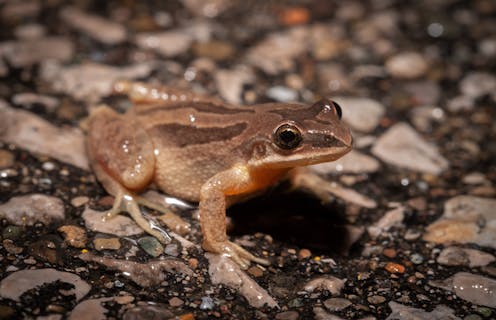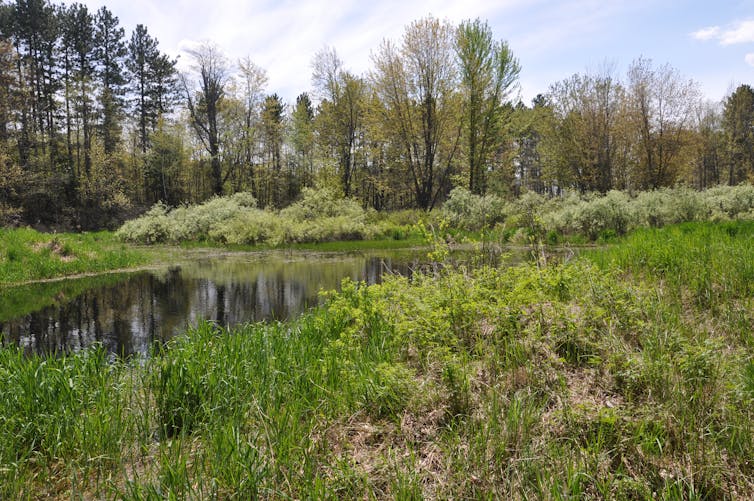
In November 2021, Canadian Minister of Environment and Climate Change Steven Guilbeault declared an emergency order that put an immediate halt on a residential development in Longueuil, Que., to protect the critical habitat of one of Canada’s threatened amphibian species — the western chorus frog.
While this was one of the few cases where the federal government applied the Species at Risk Act to cease development on private land, the Canadian Shield’s population of western chorus frog — in addition to many other closely related species — has declined over the past 60 years and continues to be an issue in Canada.
It was recently announced that the proposed route of Highway 413 in Ontario will impact the habitat of 11 species at risk, including the western chorus frog. The recent disappearance of this frog and its habitat — specially in portions of Ontario and Québec — has caused substantial concern and controversy.
As a behavioural ecologist specializing in acoustics and a reproductive endocrinologist who invented an injectable hormone mixture that induces frog breeding, we believe hope still exists. Habitat protection and restoration, advanced reproductive technologies and reintroduction procedures are all at our fingertips. This multifaceted approach could help slow further declines of chorus frogs and other amphibians.
Global and local threats
Despite its small size — measuring only two to three centimetres in length and often weighing less than two grams — the western chorus frog produces a loud, clear trill that is reminiscent of running a thumb across a plastic comb.
Historically, it was one of the most abundant amphibians in eastern Ontario and Québec. Now, it is found in only 10 per cent of their original range.

Amphibians, including the western chorus frog and other frogs, toads and salamanders, play critical ecological roles in the environment. They are vital pieces in the local food chain. They are also economically important, as they provide free pest control in residential areas by consuming insect species, such as mosquitoes and blackflies, without the need of pesticides that are potentially harmful to wildlife.
Across the world, these amphibian species are rapidly disappearing due to habitat loss, disease, pollution, harvesting, invasive species and climate change. Over 40 per cent of species are threatened with extinction. Amphibian declines are part of the sixth mass extinction event on Earth, on a scale that is approaching the loss of dinosaurs.
Captive breeding can aid reintroduction of frogs
One strategy for conserving declining species is to collect individuals from the wild and breed them in laboratory or captive settings.
This allows the offspring to grow without being threatened by predators, contaminants or other disturbances. The healthy offspring can then be released to boost numbers in the natural environment.
Along with Marc Mazerolle’s team at Laval University, we implemented this strategy through a recent collaborative effort with the Montreal Biodome and Sépaq (Société des établissements de plein air du Québec), with the goal of increasing the number of healthy individuals that can be released into appropriate restored natural sites to the benefit of all.
Two years into the project, adult chorus frogs have been successfully bred in captivity. Hundreds of tadpoles have been reared to froglets and released in constructed wetlands for the species. Some of the introduced individuals survived their first winter and adult males could be heard calling for females this past spring. These methods can be applied to species around the world.
The critical role of awareness and conservation
The first step is to spread awareness to emphasize the importance of amphibians and the speed at which species are declining. There are several resources and citizen science projects dedicate to the protection of amphibians, such as Partners in Amphibian and Reptile Conservation and Amphibian Survival Alliance.
Protection of wetlands from destruction and pollution is one of the best ways to help. Wetlands are critical to the survival of amphibians. During the construction of housing developments and infrastructure — such as the proposed Highway 413 — wetlands are often drained or filled in. Wetlands host many beautiful bird and plant species, not only amphibians, and they act as the earth’s filter to increase water quality.

Being careful while walking or driving near wetlands is another way to help on an individual level. Avoid disturbing breeding amphibians. Leave the tadpoles in the water. Observe and enjoy watching them grow legs and climb out of the water for the first time! Protecting the local ponds near your home can also contribute to this conservation.
You can also participate in public forums and let your community know that you support sustainable and responsible land use that keeps wetland habitats connected and protects critical areas for threatened species. Form volunteer groups to help protect frogs as they migrate over roads in the spring breeding season, as seen in other countries. We all have the power to make a positive difference in the protection of amphibians.
Jeffrey Ethier receives funding from the Natural Sciences and Engineering Research Council of Canada (NSERC).
Vance L Trudeau receives funding from Environment and Climate Change Canada and Ministère des Forêts, de la Faune et des Parcs.
This article was originally published on The Conversation. Read the original article.







